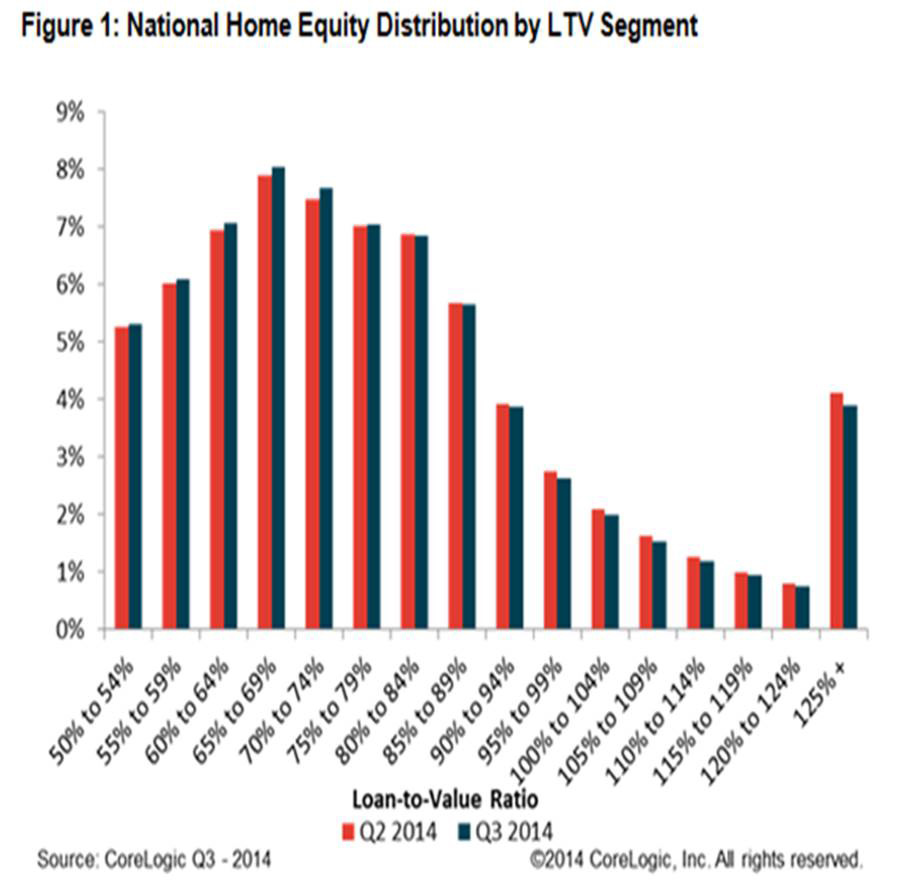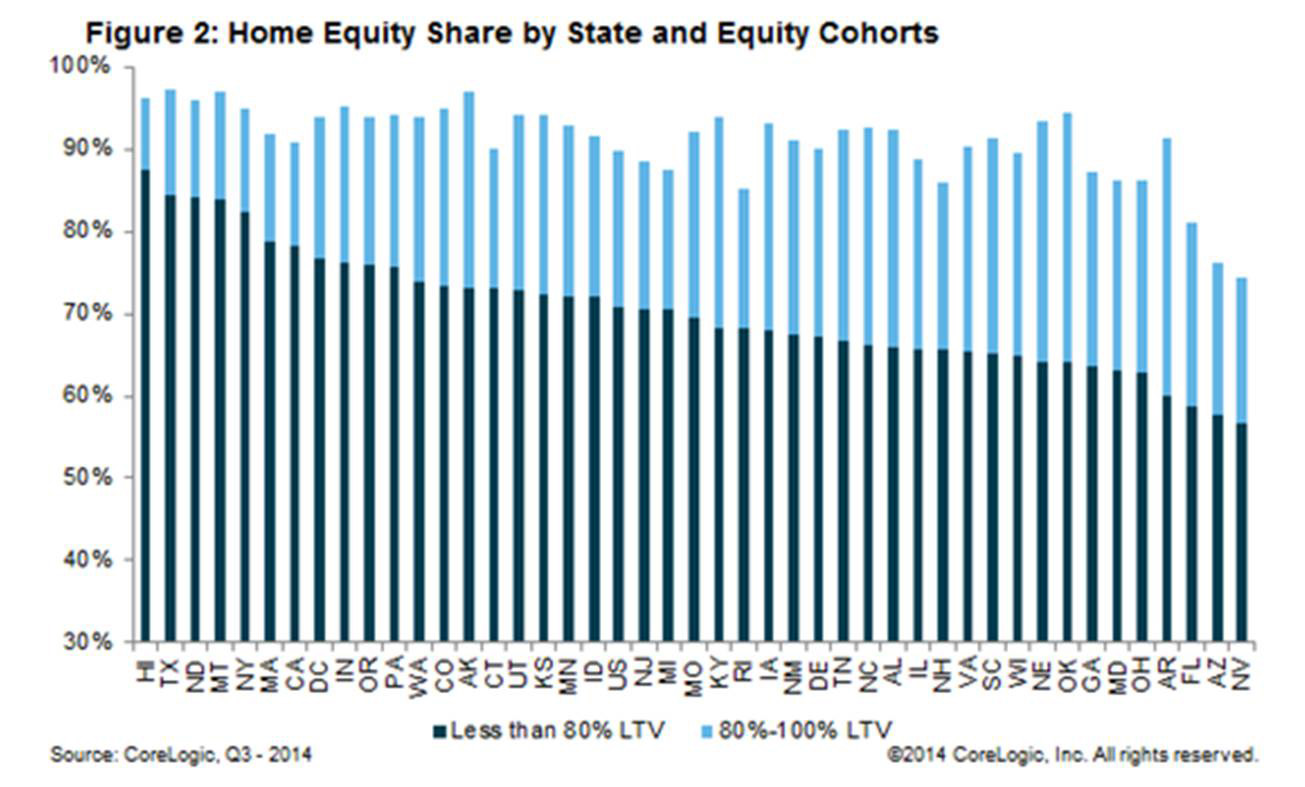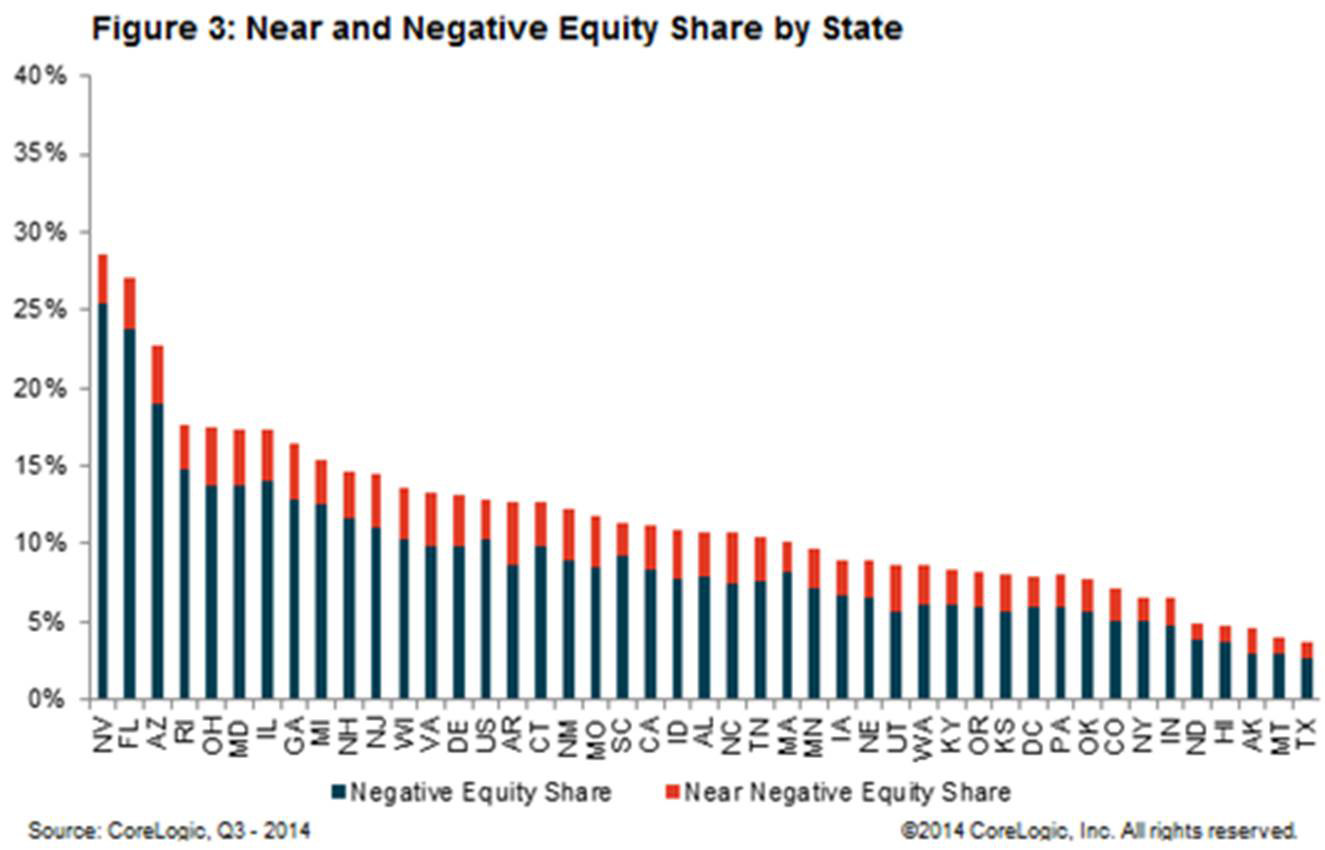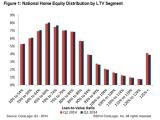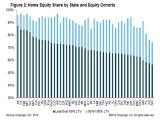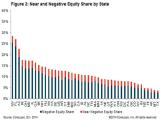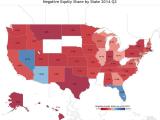CoreLogic Reports 273,000 Residential Properties Regained Equity in Q3 2014
—5.1 Million Properties Remain in Negative Equity—
Negative equity, often referred to as “underwater” or “upside down,” means that borrowers owe more on their mortgages than their homes are worth. Negative equity can occur because of a decline in value, an increase in mortgage debt or a combination of both.
For the homes in negative equity status, the national aggregate value of negative equity was $338 billion at the end of Q3 2014, down $10.2 billion from approximately $348.2 billion in the second quarter 2014. On a year-over-year basis, the value of negative equity declined from $403.2 billion in Q3 2013, representing a decrease of 16.2 percent in 12 months.
Of the 44.6 million residential properties with positive equity, approximately 9.4 million, or 19 percent, have less than 20-percent equity (referred to as “under-equitied”) and 1.3 million of those have less than 5-percent equity (referred to as near-negative equity). Borrowers who are “under-equitied” may have a more difficult time refinancing their existing homes or obtaining new financing to sell and buy another home due to underwriting constraints. Borrowers with near-negative equity are considered at risk of moving into negative equity if home prices fall. In contrast, if home prices rose by as little as 5 percent, an additional 1 million homeowners now in negative equity would regain equity.
“Nationally, the negative equity share is down over three percentage points over the past year. Declines were concentrated in a handful of states, such as Nevada, Georgia, Michigan and Florida,” said Sam Khater, deputy chief economist for CoreLogic. “Forecasted house price appreciation of about five percent over the next year suggests that negative equity should be at about 8 percent a year from now, still above average, but approaching the pre-crisis level.”
“Negative equity continued to decrease in the third quarter as did the level of homes mired in the foreclosure process. This should hopefully translate into less friction in the housing market as we move forward,” said Anand Nallathambi, president and CEO of CoreLogic. “Better fundamentals supporting homeownership in the face of higher rents should attract more first-time homebuyers to the market this year and next.”
Highlights as of Q3 2014:
- Nevada had the highest percentage of mortgaged properties in negative equity at 25.4 percent, followed by Florida (23.8 percent), Arizona (19 percent), Rhode Island (14.8 percent) and Illinois (14.1 percent). These top five states together account for 33.1 percent of negative equity in the United States.
- Texas had the highest percentage of mortgaged residential properties in an equity position at 97.4 percent, followed Alaska (97.1 percent), Montana (97.1 percent), Hawaii (96.4 percent) and North Dakota (96.1 percent).
- Of the 25 largest Core Based Statistical Areas (CBSAs) based on population, Tampa-St. Petersburg-Clearwater, Fla., had the highest percentage of mortgaged properties in negative equity at 25.5 percent, followed by Phoenix-Mesa-Scottsdale, Ariz. (19.3 percent), Chicago-Naperville-Arlington Heights, Ill. (16.3 percent), Riverside-San Bernardino-Ontario, Calif. (15 percent) and Atlanta-Sandy Springs-Roswell, Ga. (14 percent).
- Of the same largest 25 CBSAs, Houston-The Woodlands-Sugar Land, Texas had the highest percentage of mortgaged properties in an equity position at 97.5 percent; followed by Dallas-Plano-Irving, Texas (97 percent); Anaheim-Santa Ana-Irvine, Calif. (96.6 percent); Portland-Vancouver-Hillsboro, Ore. (96.4 percent) and Denver-Aurora-Lakewood, Col. (95.9 percent).
- Of the total $338 billion in negative equity, first liens without home equity loans accounted for $178 billion, or 53 percent, aggregate negative equity, while first liens with home equity loans accounted for $160 billion, or 47 percent.
- Approximately 3 million underwater borrowers hold first liens without home equity loans. The average mortgage balance for this group of borrowers is $230,000. The average underwater amount is $58,000.
- Approximately 2.1 million underwater borrowers hold both first and second liens. The average mortgage balance for this group of borrowers is $299,000.The average underwater amount is $78,000.
- The bulk of home equity for mortgaged properties is concentrated at the high end of the housing market. For example, 94 percent of homes valued at greater than $200,000 have equity compared with 85 percent of homes valued at less than $200,000.
*Q2 2014 data was revised. Revisions with public records data are standard, and to ensure accuracy, CoreLogic incorporates the newly released public data to provide updated results.
Figure 1: National Home Equity Distribution by LTV Segment
Figure 2: Home Equity Share by State and Equity Cohorts
Figure 3: Near-Negative and Negative Equity Share by State
Map 1: Under-Equity and Negative Equity Share Combined by County Map
State Table: CoreLogic Q3 2014 Negative Equity by State*
Louisiana, Maine, Mississippi, South Dakota, Vermont, West Virginia and Wyoming have insufficient equity data to report at this time.
*This data only includes properties with a mortgage. Non-mortgaged properties are by definition not included.
** Defined as properties within 5 percent of being in a negative equity position.
Methodology
The amount of equity for each property is determined by comparing the estimated current value of the property against the mortgage debt outstanding (MDO). If the MDO is greater than the estimated value, then the property is determined to be in a negative equity position. If the estimated value is greater than the MDO, then the property is determined to be in a positive equity position. The data is first generated at the property level and aggregated to higher levels of geography. CoreLogic data includes 49 million properties with a mortgage, which accounts for more than 85 percent of all mortgages in the U.S. CoreLogic uses its public record data as the source of the MDO, which includes both first-mortgage liens and second liens, and is adjusted for amortization and home equity utilization in order to capture the true level of MDO for each property. The calculations are not based on sampling, but rather on the full data set to avoid potential adverse selection due to sampling. The current value of the property is estimated using a suite of proprietary CoreLogic valuation techniques, including valuation models and the CoreLogic Home Price Index (HPI). Only data for mortgaged residential properties that have a current estimated value is included. There are several states or jurisdictions where the public record, current value or mortgage coverage is thin. These instances account for fewer than 5 percent of the total U.S. population.
Source: CoreLogic
The data provided is for use only by the primary recipient or the primary recipient’s publication or broadcast. This data may not be re-sold, republished or licensed to any other source, including publications and sources owned by the primary recipient’s parent company without prior written permission from CoreLogic. Any CoreLogic data used for publication or broadcast, in whole or in part, must be sourced as coming from CoreLogic, a data and analytics company. For use with broadcast or web content, the citation must directly accompany first reference of the data. If the data is illustrated with maps, charts, graphs or other visual elements, the CoreLogic logo must be included on screen or web site. For questions, analysis or interpretation of the data contact Lori Guyton at [email protected] or Bill Campbell at [email protected]. Data provided may not be modified without the prior written permission of CoreLogic. Do not use the data in any unlawful manner. This data is compiled from public records, contributory databases and proprietary analytics, and its accuracy depends upon these sources.
About CoreLogic
CoreLogic (NYSE: CLGX) is a leading global property information, analytics and data-enabled services provider. The company’s combined data from public, contributory and proprietary sources includes over 3.5 billion records spanning more than 40 years, providing detailed coverage of property, mortgages and other encumbrances, consumer credit, tenancy, location, hazard risk and related performance information. The markets CoreLogic serves include real estate and mortgage finance, insurance, capital markets, and the public sector. CoreLogic delivers value to clients through unique data, analytics, workflow technology, advisory and managed services. Clients rely on CoreLogic to help identify and manage growth opportunities, improve performance and mitigate risk. Headquartered in Irvine, Calif., CoreLogic operates in North America, Western Europe and Asia Pacific. For more information, please visit www.corelogic.com.
CORELOGIC and the CoreLogic logo are trademarks of CoreLogic, Inc. and/or its subsidiaries.
# # #
Media Contacts:
For real estate industry and trade media:
Bill Campbell
[email protected]
212-995-8057
For general news media:
Andrea Hurst
[email protected]
405-487-7721

